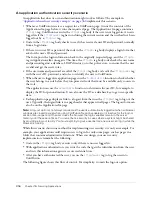
Implementing user security
359
The following table describes the CFML code in Application.cfm and its function:
Example: securitytest.cfm
The securitytest.cfm page shows how any application page can use ColdFusion user authorization
features. The web server ensures the existence of an authenticated user, and the Application.cfm
page ensures that the user is assigned to roles the page content appears. The securitytest.cfm page
uses the
IsUserInRole
and
GetAuthUser
functions to control the information that is displayed.
The securitytest.cfm page consists of the following:
<!DOCTYPE HTML PUBLIC "-//W3C//DTD HTML 4.01 Transitional//EN">
<html>
<head>
<title>Basic authentication security test page</title>
</head>
<body>
<cfoutput>
<h2>Welcome #GetAuthUser()#!</h2>
</cfoutput>
ALL Logged-in Users see this message.<br>
<br>
<cfscript>
if (IsUserInRole("admin"))
WriteOutput("Users in the admin role see this message.<br><br>");
if (IsUserInRole("user"))
WriteOutput("Everyone in the user role sees this message.<br><br>");
</cfscript>
</body>
</html>
Code
Description
<cfapplication name="Orders"
Identifies the application. The login information on
this page only applies to this application.
<cflogin>
<cfif IsDefined( "cflogin" )>
<cfif cflogin.name eq "admin">
<cfset roles = "user,admin">
<cfelse>
<cfset roles = "user">
</cfif>
Executes if there is no logged-in user.
Makes sure the user is correctly logged-in by the
web server. (Otherwise, there would be no
cflogin
variable.)
Sets a roles variable based on the user’s ID.
Assigns users named "admin" to the admin role.
Assigns all other users to the users role.
<cfloginuser name = "#cflogin.name#"
password = "#cflogin.password#"
roles = "#roles#" />
Logs the user into the ColdFusion security system
and specifies the user’s password, name, and
roles. Gets the password and name directly from
the cflogin structure.
<cfelse>
<!--- this should never happen --->
<h4>Authentication data is missing.</h4>
Try to reload the page or contact the
site administrator.
<cfabort>
This code should never run, but if the user
somehow got to this page without logging in to the
web server, this message would display and
ColdFusion would stop processing the request.
</cfif>
</cflogin>
Ends the if/else block.
Ends the
cflogin
tag body.
Содержание ColdFusion MX
Страница 1: ...Developing ColdFusion MX Applications...
Страница 22: ...22 Contents...
Страница 38: ......
Страница 52: ...52 Chapter 2 Elements of CFML...
Страница 162: ......
Страница 218: ...218 Chapter 10 Writing and Calling User Defined Functions...
Страница 250: ...250 Chapter 11 Building and Using ColdFusion Components...
Страница 264: ...264 Chapter 12 Building Custom CFXAPI Tags...
Страница 266: ......
Страница 314: ...314 Chapter 14 Handling Errors...
Страница 344: ...344 Chapter 15 Using Persistent Data and Locking...
Страница 349: ...About user security 349...
Страница 357: ...Security scenarios 357...
Страница 370: ...370 Chapter 16 Securing Applications...
Страница 388: ...388 Chapter 17 Developing Globalized Applications...
Страница 408: ...408 Chapter 18 Debugging and Troubleshooting Applications...
Страница 410: ......
Страница 426: ...426 Chapter 19 Introduction to Databases and SQL...
Страница 476: ...476 Chapter 22 Using Query of Queries...
Страница 534: ...534 Chapter 24 Building a Search Interface...
Страница 556: ...556 Chapter 25 Using Verity Search Expressions...
Страница 558: ......
Страница 582: ...582 Chapter 26 Retrieving and Formatting Data...
Страница 668: ......
Страница 734: ...734 Chapter 32 Using Web Services...
Страница 760: ...760 Chapter 33 Integrating J2EE and Java Elements in CFML Applications...
Страница 786: ...786 Chapter 34 Integrating COM and CORBA Objects in CFML Applications...
Страница 788: ......
Страница 806: ...806 Chapter 35 Sending and Receiving E Mail...
















































